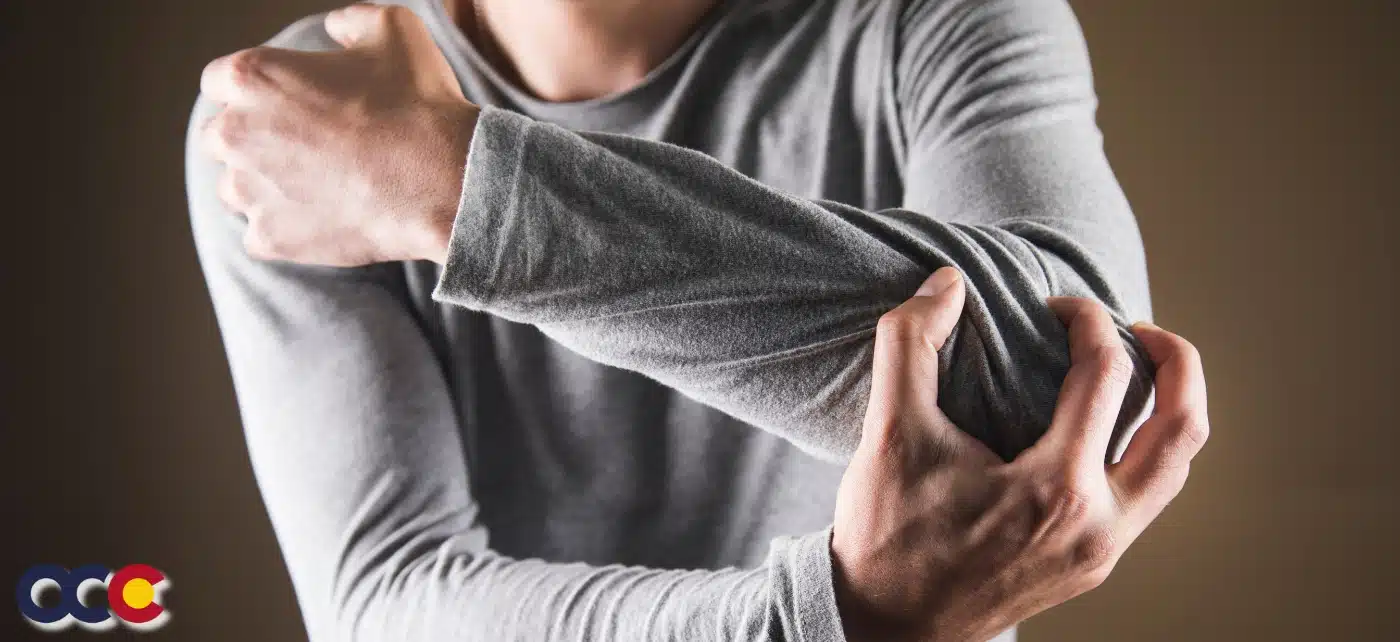Elbow dislocation happens when any of the three bones in the elbow joint are knocked or pushed out of place. Dislocating the elbow often results in excruciating pain and can make it hard or even impossible to move the elbow. The longer the elbow remains out of the joint, the more damage can occur. This is why you want to seek help from orthopedic experts who have had vast experience diagnosing and treating elbow dislocations, like those you’ll find at OCC – Advanced Orthopedic & Sports Medicine Specialists in Denver, Parker, or Aurora, Colorado. Trying to force a dislocated elbow back in place on your own can make the injury worse, damage the tissue around it, and cause serious complications.
OVERVIEW
Elbows are one of the most commonly dislocated joints each year, constituting 10% to 25% of all injuries to the elbow. Only shoulders and fingers are dislocated more often. Elbow dislocation occurs when the humerus, ulna, and radius (elbow bones) move and become dislocated or out of joint. There are two types of elbow dislocations:
- Posterior dislocation occurs when there is significant force on the palm that resonates toward the elbow and the elbow joint pushes backward (posterior). More than 90% of elbow dislocations are posterior.
- Anterior dislocation is less common and results from applying force on a flexed elbow. In this case, the elbow joint pushes forward (anterior). Elbow dislocations constitute Adolescent males are at the highest risk for dislocation, although it often occurs in children.
Of all elbow dislocations, 10-50% are sports-related.
ABOUT THE ELBOW
The elbow is the place where the bone of the upper arm meets the bones of the lower arm. The upper arm contains one bone, the humerus, which stretches from the elbow to the shoulder. The forearm has two bones, the ulna and radius, which reach from the elbow to the wrist. The ulna is the bone on the inner part of the arm, and the radius is the bone on the outer part of the arm. The ends of the bones are covered with cartilage. Cartilage has a rubbery consistency that allows the joints to slide easily against one another and absorb shock. The elbow is made up of a hinge joint and a ball-and-socket joint, enabling these two unique motions: the hinge function allows the arm to straighten and bend, and the ball-and-socket function allows the palm to rotate up or face down. The bones are held together by ligaments to provide stability to the joint. Muscles and tendons move the bones around each other and help in performing various activities.
WHAT IS ELBOW DISLOCATION?
Elbow dislocations can be complete (luxation) which happens when the bones in the joint are totally separated and pushed out of place. Subluxation is the medical term for a partial dislocation. It is a subluxation if something pulls the joint apart, and the bones still touch, just not as completely as usual. Providers also classify elbow dislocations based on the damage to the joint and surrounding tissue. A simple elbow dislocation is when there is injury to the ligaments that support the elbow but no injury to the bones that form the elbow joint. In a complex elbow dislocation, there are severe injuries to the ligaments and tendons, and also bone fractures. Severe elbow dislocation indicates damage to the nerves and blood vessels around the elbow. Should the blood vessels and nerves that travel across the elbow become injured, there is a risk of losing the arm.
CAUSES
Any force that’s strong enough to push the elbow joint out of place can cause a dislocation:
- Car accidents
- Falls—especially catching oneself or bracing for an impact with arms stretched out in front
- Athletes who play contact sports such as football, rugby, hockey, or basketball
- Female gymnasts or skaters
- Volleyball
- Downhill skiing
- Repeated elbow injuries
- People with health conditions that weaken joint ligaments
- Having loose ligaments ( being very flexible or double-jointed)
- Children who are grabbed or lifted by the arm
- People who overuse their elbows, especially doing repetitive motions at work
SYMPTOMS
- Bruising
- Pain
- Swelling
- Inflammation
- Elbow appears noticeably different or out of place
- Being unable to move or use the elbow
- Feeling of instability or like the elbow is weaker than usual
- Numbness and tingling
- In some cases, feeling may be lost in the hand, or a pulse can’t be felt in the wrist
NON-SURGICAL TREATMENTS
The first course of treatment is the quick relocation of the bones by a healthcare provider to restore the joint to its normal position. This is called manipulation or closed reduction without the need for surgical incisions. Once the joint is back in place, other non-invasive measures may be taken:
- Raising the elbow above the heart level to reduce swelling
- Icing
- Anti-inflammatory medicines such as ibuprofen (Motrin or Advil) or naproxen (Aleve) to help alleviate pain and swelling
- Minor pain relievers such as acetaminophen (Tylenol)
- Immobilization with a splint, cast, or brace
- Activity modification
- Rest
- Strengthening exercises/physical therapy
WHEN IS SURGERY INDICATED?
Most people don’t need surgery after dislocating the elbow. If the dislocation is complete or is accompanied by bone fractures and torn ligaments and tendons, surgery may be required to repair the damage and reduce the chance of elbow instability and more serious complications. Using advanced arthroscopic surgery, the surgeon will make a small incision in the elbow and insert a very thin, flexible tube with a tiny light and camera at the end. This instrument is called an arthroscope. The arthroscope magnifies and illuminates the structures within the elbow. Arthroscopic surgical techniques allow for quicker recovery times and less pain.
GETTING THE RIGHT DIAGNOSIS. GETTING THE RIGHT DOCTOR.
The most important thing to know about elbow dislocation is never trying to reset the elbow on your own. At Advanced Orthopedics in Denver, Parker, or Aurora, Colorado, their accomplished surgeons diagnose and treat elbow dislocations with exacting skill. After a detailed and thorough exam, X-rays will be ordered. However, small elbow fractures associated with dislocations can be missed on X-rays, so additional imaging may be required. If your surgeon suspects an injury to the artery, they will order tests such as a CT scan, ultrasound, or MRI. The experienced surgical professionals at Advanced Orthopedics are skilled at carefully reviewing and interpreting advanced imaging. This allows for an accurate diagnosis that leads to optimal treatment plans. With their extensive capability and attentive care, you can feel confident you’ll get the best results. Schedule an appointment today.













